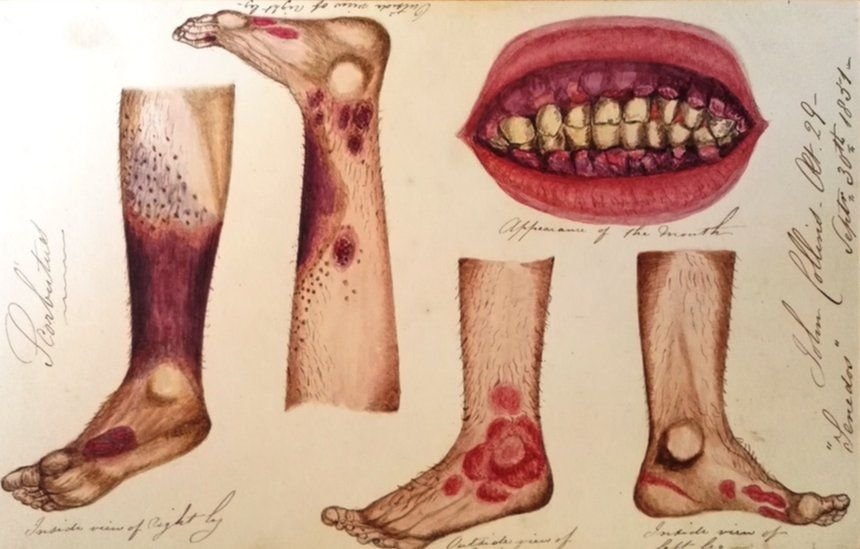RATS!
Sailors in port, courtesy of the Royal Maritime Museum, Greenwich
In ‘Dragon’ Chapter 6, young Dr Marshall is discussing the alarming number of scurvy cases aboard HMS Mars with his superior Dr McParland, the curmudgeonly senior surgeon. The following conversation takes place between them…
‘…Perhaps, as Dr Lind believes, some quality of the citrus is the key. But until such time we venture into Spain for its oranges or Italy for its lemons, then my suggestion is to ask the little boys to catch as many rats as they can. Give them a farthing each, that’ll get them going ...’
‘Rats?’ Marshall queried. ‘To what end?’
The doctor rested back in his chair and tapped his nose. ‘Old sailors’ remedy for scurvy. Skin a few rats and add the flesh to the gruel in sick bay. It won’t cure them, but it slows the progression of the disease. It will give us some time. We may not have oranges, sir, but of rats we have plenty. It has the added benefit of keeping down their number.’
Marshall tried to make the doctor see reason, citing the possibility of disease from the rats spreading to the men, but McParland was obdurate. A few of the youngest boys were offered a monetary reward for rats, under the pretence of reducing their numbers in the
dwindling stores. Little Jemmie proved the champion ratcatcher, his pockets permanently stuffed with bodies, amassing quite a sum in coin.
‘I used to catch ’em for me Ma,’ he observed when complimented for his skills. ‘We had ’undreds of ’em in our place.’ Marshall did not dare inquire as to his mother’s purpose,
suspecting that the rodents may have been a food source for the starving family. The loblollies were instructed in the preparations of the porridge – and sworn to secrecy. No man would eat or even report sick if he suspected what was being fed in sickbay, should
the story come out.
Thus, the unorthodox treatment was ladled out meal after meal, and to Marshall’s astonishment, the results were remarkably promising. Just as McParland had said, the men were not cured but their condition did improve, sufficiently in many cases for light duties to be resumed. The worst of the outbreak was kept at bay for the time being. An unexpected consequence of the treatment was that many of the patients, formerly exhibiting the
dejection of spirits that always accompanied scurvy, now began to show more interest in life, particularly at meal times. ‘I never ate gruel so tasty,’ one said. ‘Just like my mother used to make,’ said another. ‘The good doctor even put some meat in it!’
Marshall recorded his findings with incredulity. Medical school had surely never prepared him for the likes of this….
Rattus Rattus - the ship rat
I came across this old sailors’ remedy for scurvy in numerous documents whilst doing my research for Penang Chronicles. The description both nauseated and intrigued me in equal measure. Was there possibly anything to it? Although it seemed unlikely, there was something oddly persuasive about the treatment. As with any old wives’ tale, there is usually something behind the folklore.
Cue to one of my deep dives down another internet rabbit hole, searching for corroboration, following my hunch that these wise old doctors were not complete fools. What was it about rat meat that treated scurvy?
Scurvy is a serious condition caused by deficiency in ascorbic acid, a.k.a Vitamin C. It usually develops in situations of extreme deprivation or starvation when a balanced diet is not possible or aboard ships on protracted journeys where fresh food and vegetables are not available. Scurvy prevents the production of collagen that protects connective tissue; it inhibits the development of antioxidants; it stops natural wound healing; and prevents neurotransmitters from producing dopamine. The disease is relatively easy to cure but if left untreated for long periods, it can cause permanent health problems – and even death. The consequences of scurvy are dreadful: gingivitis and tooth loss, anaemia, skin haemorrhages, blurred vision, swollen joints, progressive bruising, chest pain, shortness of breath, gastro-intestinal bleeding – and severe depression.
Scurvy Images courtesy of the BBC
It is traditionally claimed that citrus fruits are the key to the fight against scurvy – and promoting good health and combating disease in general. Dr James Lind (1716-94), the Scottish ship doctor whose endeavours to prove the efficacy of the citrus in the fight against scurvy on long voyages, made the case successfully. Ultimately, British sailors were forever after referred to as ‘limeys’ for the stipulation that citrus fruits should be part of every ship’s stores. Lind had not been the first doctor to suggested fresh produce was essential to eradicating scurvy in the navy. The value of fruits had been observed for a long time; sailors in tropical or Mediterranean ports regularly showed evidence of recovery from scurvy when fresh foods were readily available. But it was through Dr. Lind’s assiduous clinical trials carried out on board HMS Salisbury in 1747 that the linkage was finally proved. Even so, it was years until this became widely known and accepted.
James Lind by George Chalmers (1720-1791) Wikipedia
Since then, much work has been done on the synthesis of ascorbic acid. Although citrus fruits are indeed a good source of Vitamin C, many other fruits and vegetables are now known to produce Vitamin C in even larger quantities: blueberries, chilis, peppers, broccoli, spinach…the list goes on and on. More evidence if we need it to eat our five a day!
Image: bebodywise.com
But why rats?
Lo and behold, I finally came across exactly what I was looking for in a footnote. Most animals, apparently, synthesise Vitamin C in their own bodies, all that is except monkeys, apes, guinea pigs – and humans. Rats, however, are particularly efficient at producing it, probably explaining their hardy systems. Plentiful aboard ship, rats were the perfect solution when far from port and fresh food sources – and hungry men will eat anything. Subsequently doctors observed a lessening of scurvy symptoms amongst men who had resorted to eating black rats as food. They did not know why it worked but worked it did. Thus, a home remedy was born as long as the flesh was not overcooked - rats assez cuit?
Naturally it would have taken a huge quantity of rat flesh eaten regularly to completely cure the condition, but as a treatment it was sufficient to ease the symptoms at least until the ship got to port and a normal diet could be resumed. Truth is stranger than fiction.
I do hope you are not about to eat dinner….





